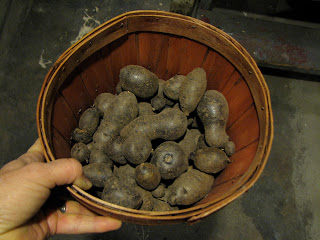It’s not exactly Indian Summer here in Zone 4, but the garden is still pumping out Fall food and I have plenty of time to bring in the potatoes.
Mine are just fine in their bins. They can stay there for quite a while, as long as the weather is mild. Eventually though, I’ll dig them up to bring them in for winter. I don’t want them to freeze and rot in those bins.
Potatoes should be cured before stored. After digging, I lay them out on newspapers in the basement where it’s cool and dark. They’ll stay there for about two weeks, until cured. Damaged spuds (like the ones you hit with the shovel) don't need curing and should be eaten immediately.
Then I’ll store them in ventilated bins, (I use bushel baskets) covered with newspaper to protect them from light. Ideally, I’d like to keep them at 35 to 40 degrees, but potatoes will keep for several months at 45 to 50 degrees.
Potatoes should not be washed before storage. It’s impossible to get them dry enough to store them well. I just gently wipe the big clumps off them after curing them.
My container potatoes did very well, so far. The small reds were nice roasted. The yellow Buttercreams were very small, but very good in Puerto Rican Chicken and Beans. The purples were the prettiest and most abundant. They were a deeper purple than a Crayola crayon and their flesh baked up a delicious, flaky lavender. Even the boys thought they were cool. They had two apiece. I still have half a dozen containers to empty. It feels like an early Christmas present.
My dad didn’t have such good luck with his potatoes, but, in his defense, he got the very end of my seed potatoes. And we really planted them too late. He took it pretty well. He had enough for a good two meals and we’ll try again next year.






